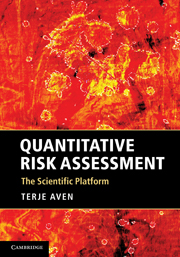Crossref Citations
This Book has been
cited by the following publications. This list is generated based on data provided by Crossref.
Xingling Huang
and
Xiangbing Huang
2011.
A risk-based design methodology for coal mine refuge chamber.
p.
199.
Aven, Terje
2011.
Response.
Risk Analysis,
Vol. 31,
Issue. 10,
p.
1538.
Aven, Terje
2012.
Foundational Issues in Risk Assessment and Risk Management.
Risk Analysis,
Vol. 32,
Issue. 10,
p.
1647.
Collins, LM
2012.
Welfare risk assessment: the benefits and common pitfalls.
Animal Welfare,
Vol. 21,
Issue. S1,
p.
73.
Ignat, S.
Stancel, E.
and
Stoian, I.
2012.
Support for condition based maintenance Operating equipment performances monitoring.
p.
234.
2012.
Foundations of Risk Analysis.
p.
197.
Hole, Kjell Jorgen
2013.
Management of hidden risks.
Computer,
Vol. 46,
Issue. 1,
p.
65.
Samad, Javeria
Loke, Seng W.
and
Reed, Karl
2013.
Quantitative Risk Analysis for Mobile Cloud Computing: A Preliminary Approach and a Health Application Case Study.
p.
1378.
Prezelj, Iztok
and
Žiberna, Aleš
2013.
Consequence-, time- and interdependency-based risk assessment in the field of critical infrastructure.
Risk Management,
Vol. 15,
Issue. 2,
p.
100.
2014.
Reliability of Safety‐Critical Systems.
p.
431.
2014.
Uncertainty in Risk Assessment.
p.
93.
Wei, Meng Yuan
Hu, Xiang Yuan
Jiang, Chun
Zang, Jia Xin
and
Xue, Wen Liang
2014.
Quantitative Risk Assessment and Early Warning for pH Value of Disqualified Imported Textile.
Advanced Materials Research,
Vol. 936,
Issue. ,
p.
2358.
Roe, Peter
Hrymak, Victor
and
Dimanche, Frederic
2014.
Assessing environmental sustainability in tourism and recreation areas: a risk-assessment-based model.
Journal of Sustainable Tourism,
Vol. 22,
Issue. 2,
p.
319.
Hansson, Sven Ove
and
Aven, Terje
2014.
Is Risk Analysis Scientific?.
Risk Analysis,
Vol. 34,
Issue. 7,
p.
1173.
Andretta, Massimo
2014.
Some Considerations on the Definition of Risk Based on Concepts of Systems Theory and Probability.
Risk Analysis,
Vol. 34,
Issue. 7,
p.
1184.
Vastveit, Kirsti Russell
Eriksson, Kerstin
and
Njå, Ove
2014.
Critical reflections on municipal risk and vulnerability analyses as decision support tools: the role of regulation regimes.
Environment Systems and Decisions,
Vol. 34,
Issue. 3,
p.
443.
Donovan, Paula J.
McLamb, Jeffrey W.
Okhravi, Hamed
Riordan, James
and
Wright, Charles V.
2015.
Quantitative evaluation of moving target technology.
p.
1.
2015.
Risk Analysis.
p.
188.
Borg, Audun
Njå, Ove
and
Torero, José L.
2015.
A Framework for Selecting Design Fires in Performance Based Fire Safety Engineering.
Fire Technology,
Vol. 51,
Issue. 4,
p.
995.
Stahl, Gerhard
2016.
Advanced Modelling in Mathematical Finance.
Vol. 189,
Issue. ,
p.
189.



